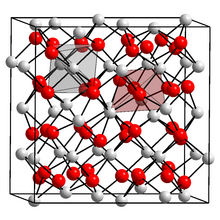Americium(III) oxide

| |
| Names | |
|---|---|
| Other names
Americium sesquioxide
| |
| Identifiers | |
3D model (
JSmol ) |
|
PubChem CID
|
|
| |
| |
| Properties | |
| Am2O3 | |
| Molar mass | 534 g·mol−1 |
| Density | 11.77 |
| Melting point | 2,205 °C (4,001 °F; 2,478 K) |
| Structure | |
| Trigonal, hP5 | |
| P3m1, No. 164 | |
a = 381.7 pm, c = 597.1 pm[1]
| |
| Related compounds | |
Other cations
|
Curium(III) oxide |
Related compounds
|
Americium dioxide Americium(II) oxide |
Except where otherwise noted, data are given for materials in their standard state (at 25 °C [77 °F], 100 kPa).
| |
Americium(III) oxide or americium sesquioxide is an oxide of the element americium. It has the empirical formula Am2O3. Since all isotopes of americium are only artificially produced, americium (III) oxide has no natural occurrence. The colour depends on the crystal structure, of which there are more than one. It is soluble in acids.[2]
Formation
Americium(III) oxide can be made by heating americium dioxide in hydrogen at 600°C.[3]
Forms
The hexagonal form is coloured tan, and the cubic form is coloured red-brown the same as persimmon.[3] The cubic form converts to the hexagonal form on heating to 800°C.[3] The cubic form is non-stoichimetric with variable oxygen composition. It darkens with increasing oxygen.[3]
References
- S2CID 261051636.
- ISBN 978-0-8493-0595-5.
- ^ .

